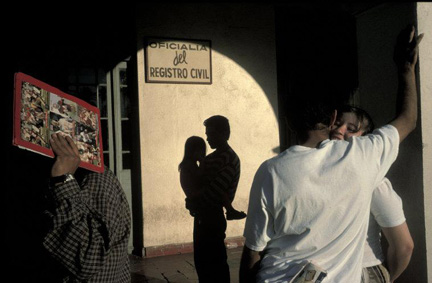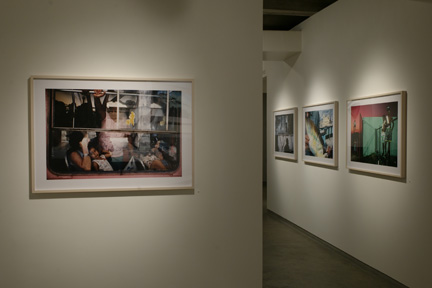For November, we decided to include TWO QUESTIONS from two West Coast photographers, Stella Kalaw and Minh Carrico (find out more about them below). In this same vein, please feel free to leave TWO COMMENTS –– one about one of Rebecca’s responses, one about one of Alex’s –– after this posting. ––AW and RNW
ON WRITING AND VISUAL COMPLEXITY
STELLA KALAW: Rebecca, I saw a few images from My Dakota on your website, and there is something quite poetic and lyrical in the way that you express yourself in this body of work. Does your background as a writer affect the way you photograph?
REBECCA NORRIS WEBB: With My Dakota –– which started out as an exploration of my relationship with the American West and ended up also becoming an elegy for my brother, Dave, who died unexpectedly –– my writing abandoned me for two years after he died. I’m not entirely sure, but perhaps the hole left by my not being able to write somehow intensified my need to photograph during this time, because it was the only way I had left to express myself.
Now, some three years after my brother’s death, my writing has returned, but it’s as spare as a treeless prairie. Maybe My Dakota will ultimately include little or no writing of my own. Maybe that’s okay. Maybe that merely reflects the particular nature of my grief. I won’t know until I start to put together the book dummy, which I plan to do this winter. For me, the return of my writing is more a sign that I’ve somehow arrived at the far side of my grief, and, from that vantage point, finally have enough distance to absorb and distill and edit and ultimately let go of the work.
S.K.: Alex, there is this visual complexity that is so inherent to your images. How did this evolve?
ALEX WEBB: I think that I have always been drawn to visually complex photographs. Many of my early photographs contain more than one element, have more than one point of focus. As the years have passed, my photographs have become increasingly complex. Now, at times I feel that I often walk a fragile line visually: pushing the frame to include more and more, just up to –– but falling short of –– chaos.
I suspect that the roots of this affinity for visual complexity –– and my increasing embrace of greater and greater complexity within the frame –– echoes my belief in the unimaginable complexity and surprise in the world, and street photography’s unique ability to capture this. For me, walking the streets with a camera is about discovery, about discovering situations that are more surprising and more startling and more complex than any moment I could have ever imagined. I’m intrigued how multiple states, multiple situations, and multiple moments, can co-exist and qualify one another. I’m drawn to photographs that don’t just show the existence of one thing, but the simultaneous existence of many things, sometimes in ways that may seem paradoxical or contradictory. In this sense, I feel that my photographs, more than anything else, raise questions: How can that, and that, and that, all simultaneously co-exist? What is the nature of this big, complex, unruly world out there that so defies our efforts to categorize it? Photography can bring something back from that world that affirms a reality and, simultaneously –– and perhaps more importantly –– that expands on our understanding of that reality.
ON EXHIBITION PRINTS AND MAKING BOOKS
Minh Carrico: Alex, after a book is published, what criteria do you use for editing the images used for the book down to a smaller number of prints for exhibition in a museum or gallery?
AW: A book is a bit like a piece of music. It needs high points and low points, stronger notes and quieter notes. And like a piece of music, if a book of photographs were made only of high notes, there would be no relief from the intensity, no variation in rhythm, no real movement to carry the viewer through the sequence of the book.
Viewing a photograph on a wall, on the other hand, is a quite different experience than looking at the image in a book. On a wall, the photograph becomes an object and demands to be experienced within its own parameters. While the viewer’s experience of the photograph on the wall may be somewhat qualified by other photographs on the wall nearby, the viewer of a photograph in a book is often much more influenced by the immediate and lingering presence of the photographs near it in the book –– especially if there are photographs on the opposite page in the book.
So, when I choose photographs for an exhibition out of one of my books, I am looking for those images that demand to be seen on their own –– that somehow validate a viewer spending time with these images in a gallery or museum and absorbing what it is they have to offer. Of course, I want the exhibition to have coherence –– hopefully that echoes at least some of the musicality of the book –– but I’m particularly concerned about whether each individual print that’s hung in the show creates its own rich and complex world.
MC: Rebecca, when editing and laying out your images for a book, how often and at what point do you consult with other people (photo editors, photographers, designer, etc) for advice in the selection and layout process?
RNW: Good question, but somewhat difficult to answer since every book is different. I guess, generally, I’d say there are roughly three stages involved in creating a book. The first is more private and involves listening intently and intuitively to the body of the work until the rough shape and rhythm of the book is revealed to you, enabling you to make a book dummy that reflects the unique world of that particular book. The second is more collaborative –– showing the work to a few creative people you trust, which may be painters and poets as well as photographers and editors. This process may help you illuminate and fine–tune your book dummy, until the sequence and rhythm feels right visually and conceptually and intuitively. With this version of the book dummy in hand, the third stage involves collaborating with a designer. If you’re fortunate to work with the right book designer, your collaboration can result in a book design that strengthens and complements the work –– often in ways you never could have imagined at the beginning of the process.
Stella Kalaw was born and raised in Manila, Philippines. She earned a BA in Communication Arts at Dela Salle University, Manila and a BA in Professional Photography at Brooks Institute of Photography in Santa Barbara, CA. Her work has been exhibited at the Singapore International Photography Festival, The Ayala Museum and at the Silverlens Gallery in Manila, Wall Space Gallery in Seattle, Kala Art Gallery in Berkeley and at the Rayko Gallery in San Francisco. She was one of the first prize recipients for the People, Places & Things: an International competition celebrating En Foco’s 35th Anniversary and received an honorable mention at the 5th International Polaroid Awards. Stella is based in the San Francisco Area.
Stella’s website: http://www.kalaw.com
Stella’s blog: http://stellakalaw.blogspot.com
Stella’s work will be featured in the three-person show, Geography, at Rayko Gallery in San Francisco from Dec. 17th – Jan. 18th, 2010: http://raykophoto.com/?page_id=38
Minh Carrico brings his passion for visual communications and real world experiences to the classroom after 16 years of working as a designer, photographer, and producer in the advertising and magazine industries. Minh teaches design and photography at Edmonds Community College just outside of Seattle, WA, where he also serves as Faculty Co-chair of the Visual Arts Program. Outside of the classroom, Minh works on a number of fine art photography projects and art installations that address identity.
Minh began his career in 1991 as an editorial photographer while attending St. Edward’s University in Austin, Texas. He opened a commercial photography studio in 1993 and started making photographs for advertising and design projects. After six years, he moved to New York City and began a career in print graphic design. His design and photography clients includes 3M, Atlantic Records, Benjamin Moore Paints, Chris Buck, Detour Magazine, Michel Gondry, Annie Leibovitz, Martha Stewart Living Omnimedia, MTV, Time Out New York Magazine, and Whole Food Market, Inc.
Minh’s website: http://www.minhcarrico.com/




















